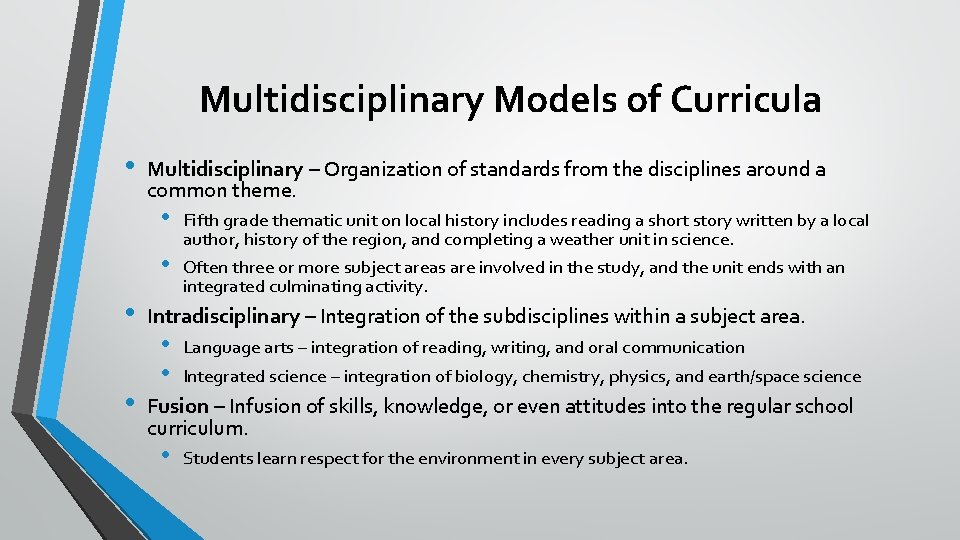Interdisciplinary And Transdisciplinary Approaches: A Key To Solving Complex Problems

Table of Contents
Understanding Interdisciplinary Research
Definition and Characteristics
Interdisciplinary research involves integrating knowledge, methods, and perspectives from multiple disciplines to address a shared problem. It's characterized by collaboration among researchers from different fields, all focused on a common research question. This collaborative effort transcends the boundaries of individual disciplines, fostering a synergistic environment where diverse expertise contributes to a more holistic understanding.
- Collaboration among researchers from different fields: For example, a project might involve biologists, engineers, and social scientists working together.
- Focus on a shared research question or problem: The unifying factor is the central research question, driving the collaborative effort.
- Integration of diverse perspectives and methodologies: Each discipline brings unique methodologies and viewpoints, enriching the overall research process.
- Potential for synergistic insights and innovative solutions: The combination of different perspectives often leads to unexpected insights and groundbreaking solutions.
Examples of Successful Interdisciplinary Projects
Successful interdisciplinary projects abound. Climate change research, for instance, requires the combined expertise of climatologists, economists, sociologists, and policymakers to develop effective mitigation and adaptation strategies. Similarly, public health initiatives often involve epidemiologists, behavioral scientists, and public health officials working together to address complex health issues. Urban planning projects benefit from the collaboration of architects, engineers, urban planners, and sociologists to create sustainable and livable cities. These examples demonstrate the power of integrating diverse perspectives to tackle complex, real-world problems.
Exploring Transdisciplinary Research
Definition and Distinctions from Interdisciplinary Research
While interdisciplinary research integrates knowledge within academia, transdisciplinary research goes further, involving stakeholders from various sectors – academia, government, industry, and the community – in the co-creation of knowledge. It moves beyond the integration of disciplines to actively engage with real-world contexts and actively involves those impacted by the research in shaping its direction and outcomes.
- Involves stakeholders from various sectors (academia, government, industry, community): This participatory nature ensures relevance and impact.
- Focus on real-world problem-solving with actionable outcomes: The goal is not just to generate knowledge, but to apply it to solve pressing problems.
- Emphasis on participatory research methods and knowledge exchange: Methods such as community forums and participatory mapping are commonly used.
- Potential for broader societal impact and sustainable solutions: By involving all stakeholders, solutions are more likely to be adopted and sustained.
Case Studies of Effective Transdisciplinary Initiatives
A successful transdisciplinary project might involve a community working with researchers to develop sustainable agricultural practices, or a collaboration between scientists, policymakers, and local communities to manage a shared natural resource. While these projects can be challenging to coordinate, the collaborative nature often leads to solutions better suited to the specific context and more readily adopted by stakeholders. Challenges often include balancing the different priorities and perspectives of stakeholders, as well as navigating bureaucratic processes and ensuring equitable participation. Success, however, lies in the creation of solutions deeply embedded in the community, leading to long-term impact.
Benefits of Interdisciplinary and Transdisciplinary Approaches
Enhanced Problem-Solving Capabilities
Combining different perspectives and methodologies significantly enhances problem-solving capabilities. A holistic understanding emerges, revealing connections and solutions that would be missed by a single-discipline approach.
- Holistic understanding of complex issues: Seeing the problem from multiple angles provides a more complete picture.
- Identification of unexpected connections and solutions: Diverse perspectives spark innovative ideas.
- Improved problem framing and innovative solutions: Collaborative brainstorming leads to more creative and effective strategies.
- Increased collaboration and knowledge sharing: Breaking down disciplinary silos fosters a culture of learning and innovation.
Fostering Innovation and Creativity
These approaches are powerful engines of innovation and creativity. By breaking down the traditional disciplinary silos, they create fertile ground for new ideas and approaches to emerge. The free exchange of ideas and methods can lead to breakthroughs that would be impossible within the confines of a single discipline. This collaborative process nurtures creative problem-solving, ultimately resulting in more effective and sustainable solutions.
Challenges and Considerations
Overcoming Barriers to Collaboration
Despite their advantages, interdisciplinary and transdisciplinary approaches present challenges:
- Communication difficulties between disciplines: Researchers from different fields may have different vocabularies and ways of thinking.
- Differing research methodologies and priorities: Integrating diverse approaches requires careful planning and coordination.
- Challenges in integrating diverse data and findings: Synthesizing information from multiple sources can be complex.
- Need for strong leadership and project management: Effective project management is essential to ensure successful collaboration.
Strategies for Successful Implementation
To mitigate these challenges, clear communication strategies, well-defined research questions, and strong project leadership are crucial. Establishing shared goals, developing common methodologies, and creating a culture of mutual respect and understanding are also vital for successful implementation. Regular communication, open dialogue, and a willingness to compromise are essential for navigating the complexities of collaborative research.
Conclusion
In conclusion, interdisciplinary and transdisciplinary approaches are not merely desirable but essential for addressing the complex challenges facing our world. By integrating diverse perspectives, fostering collaboration, and promoting knowledge exchange, these methodologies enhance problem-solving, stimulate innovation, and ultimately lead to more effective and sustainable solutions. While challenges exist, the benefits far outweigh the difficulties. We urge researchers, policymakers, and community members to embrace and champion these approaches, actively seeking opportunities to participate in collaborative projects and further explore the potential of interdisciplinary and transdisciplinary research to shape a better future.

Featured Posts
-
 Trump Administrations Impact On Library Funding And Staffing
May 19, 2025
Trump Administrations Impact On Library Funding And Staffing
May 19, 2025 -
 World Cup Qualifying Haaland Propels Norway To 5 0 Victory
May 19, 2025
World Cup Qualifying Haaland Propels Norway To 5 0 Victory
May 19, 2025 -
 London Festival Regulations A Potential Crisis For Live Music
May 19, 2025
London Festival Regulations A Potential Crisis For Live Music
May 19, 2025 -
 Paige Bueckers Senior Day Huskies Of Honor Induction Ceremony
May 19, 2025
Paige Bueckers Senior Day Huskies Of Honor Induction Ceremony
May 19, 2025 -
 Muere Juan Aguilera Adios A La Leyenda Del Tenis Espanol
May 19, 2025
Muere Juan Aguilera Adios A La Leyenda Del Tenis Espanol
May 19, 2025
